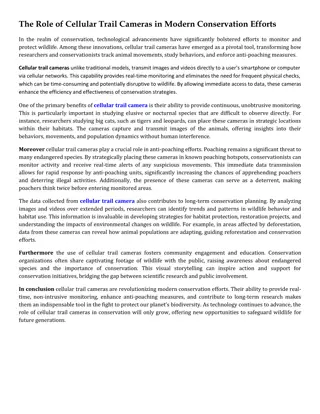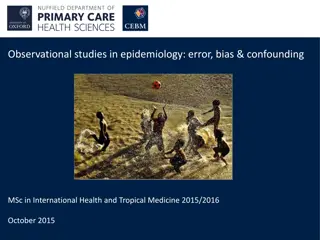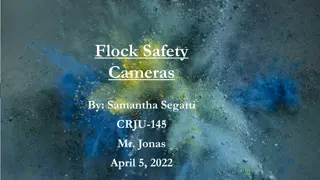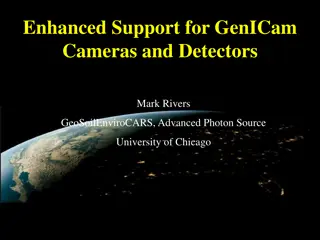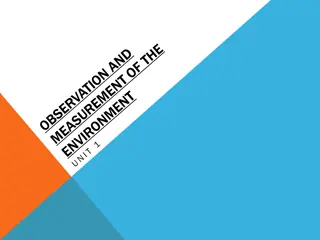Observational Study on Red Light Cameras' Impact on Driver Behavior
The study focuses on determining if the installation of red light cameras at a busy intersection reduces the number of drivers running red lights. It discusses the data collection plan, including the focus on the number of cars running red lights, the sampling methods, such as simple random and stratified random sampling, and potential class discussion topics. The study also considers driver behavior at different times of the day using a stratified random sample.
Download Presentation

Please find below an Image/Link to download the presentation.
The content on the website is provided AS IS for your information and personal use only. It may not be sold, licensed, or shared on other websites without obtaining consent from the author.If you encounter any issues during the download, it is possible that the publisher has removed the file from their server.
You are allowed to download the files provided on this website for personal or commercial use, subject to the condition that they are used lawfully. All files are the property of their respective owners.
The content on the website is provided AS IS for your information and personal use only. It may not be sold, licensed, or shared on other websites without obtaining consent from the author.
E N D
Presentation Transcript
Take out your Task from Yesterday ! I also need the And You believed that Assignment April 4th, 2013
Vocab You NEED TO KNOW! Bias Unbias Simple Random Sample Systematic Sample Stratified Random Sample Cluster Sample
Examples #6 Simple Random Sample Systematic Sample Stratified Random Sample Cluster Sample
And you believed That task Assignment 1. C is unbiased 2. C is unbiased 3.Cluster sampling 4. Simple Random sampling 5. Systematic Sampling 6. Stratified Random sampling 7. Cluster sampling 8. Stratified Random sampling 9. Simple Random sampling 10. Systematic Sampling 11. Cluster sampling
1. A local community has just installed red light cameras at its busiest intersection. The police department hopes that the cameras will encourage drivers to be more careful and that incidents of drivers running red lights at this intersection will decrease. Design an observational study that the police department could use to determine if the installation of the traffic light has had the deserved effect. a.What is the focus of the study? Do red light cameras reduce the number of drivers who run red lights? . What is the variable of interest? Number of cars running a red light at the city s busiest intersection
Determine the data collection plan. Answers will vary. One response might be to collect data for one month prior to the installation of the camera and then for one month following the installation of the cameras. A student might include sampling in his/her response by saying that data might be collected only on certain days of the week or at given times of the day. Funds are limited and there are only a few days to conduct the study. What is the most appropriate sampling method? Students should incorporate a simple random sample into the response. However, their specific responses will vary. The police chief also wonders if there is a difference in driver behavior at different times of day. Can you incorporate this concern into your sampling method? A stratified random sample should be used. The strata students use may vary. Possible strata are morning, afternoon and evening. Another method might be heavy commute times vs. times when most people are at work. ** C and D provide good opportunities for class discussion once groups have determined their sampling methods.**
2. A few years ago, a study was conducted at John Hopkins hospital in Boston to see if exposure to ultrasound could affect the birth weight of a baby. Investigators followed unborn babies and their mothers until their birth and notes their birth weight. A comparison was made between the birth weight of those babies exposed to ultrasound and those babies not exposed to ultrasound. Whether an ultrasound was used on the baby was a decision made by the mother s doctor, based on medical justification. Was this study an experiment or an observational study? Explain. List any possible confounding variables in this study. (source: Chris Franklin, University of Georgia) Observational study While the study does compare two groups, it is not an experiment because the group the babies went into was determined by the mother s doctor, based on medical justification. There was no randomization. Confounding variables Answers will vary. Make sure that students justify how the variable they suggest would result in a group difference being observed. One possible confounding variable is the mother s age and/or health.
Suppose the faculty of a Statistics department at a large university wanted to look at how students in the introductory Statistics courses might perform on exams under different environmental conditions. They decided to consider the effect of the size of the classroom (a smaller classroom where there are just enough seats for the students versus a large classroom where the students can spread out with an empty seat between each student). When the next exam is given in one section of the introductory Statistics course, 60 students will be randomly assigned to one of the treatments. The scores on the exam will then be compared. (source: Chris Franklin, University of Georgia) a. Is this study an experiment or observational study. Explain. Experiment Subjects are randomly assigned to treatment groups. There are a significant of subjects for replication and there are two treatment groups to control for lurking variables. b. Name the explanatory factor. size of the classroom
Suppose the faculty of a Statistics department at a large university wanted to look at how students in the introductory Statistics courses might perform on exams under different environmental conditions. They decided to consider the effect of the size of the classroom (a smaller classroom where there are just enough seats for the students versus a large classroom where the students can spread out with an empty seat between each student). When the next exam is given in one section of the introductory Statistics course, 60 students will be randomly assigned to one of the treatments. The scores on the exam will then be compared. (source: Chris Franklin, University of Georgia) c. Name the response variable. exam score d. How many treatments will this study compare? Name the treatments. Two treatments (classroom size) smaller classrooms and larger classrooms
4. You want to determine the best color for attracting cereal leaf beetles to boards on which they will be trapped. You will compare four colors: blue, green, white and yellow. You plan to count the number of beetles trapped. You will mount one board on each of 16 poles evenly spaced in a square field.
b. What is the explanatory variable? board color
c. What are the treatments? blue, green, white and yellow
d. What is the response variable? number of beetles trapped
e. Outline the design of the above experiment.




